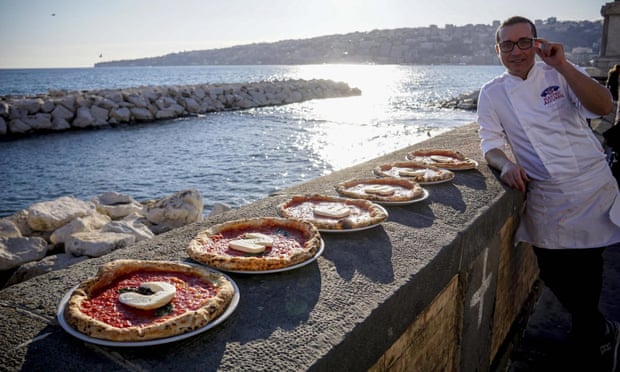
'Photo: Cesare Abbate/EPA
Italian chef Gino Sorbillo with pizza spelling out ‘Unesco’ in Naples on Friday.
'Wants style distinguished from rivals such as New York pizza, saying it is central to Italian identity'
Italy will put forward the art of Neapolitan pizza-making for inclusion in Unesco’s prestigious cultural heritage list this year, after the country’s Unesco commission unanimously confirmed its candidacy, which was proposed by the government.
The proposal was boosted by a petition that collected more than 850,000 signatures, from the streets of Naples all the way to Japan and Argentina.
The selection commission said the art of pizza-making was a central element of Neapolitan and Italian identity, and a symbol of the brand of Italy around the world. Italy wants the Neapolitan pizza to be distinguished from rivals such as New York-style pizza.

Photo: Mark Peterson/Corbis
Customers eating pizza in Manhattan, New York.
According to Coldiretti, the Italian association of agricultural entrepreneurs, the pizza industry is worth €10bn (£8bn) and employs 100,000 people.
A dossier making the case for Neapolitan pizza will now be submitted to Unesco. After a year-long process that will involve 200 countries, a decision on what to include in the list will be taken in Paris in 2017.
According to the rules set out by the Association of the Real Neapolitan Pizza, a genuine Neapolitan pizza dough consists of wheat flour (type 0 or 00, or a mixture of the two), compressed biologically produced yeast, sea salt and water. The dough must be kneaded by hand or with a low-speed mixer. After the rising process, the dough should be formed without the help of a rolling pin or other machine, and it may be no more than 3mm thick.
Real Neapolitan pizza is limited to two types: marinara (tomato, oil, oregano and garlic) and margherita (tomato, oil, mozzarella or fior di latte, grated cheese and basil).
Unesco’s list of Intangible Cultural Heritage of Humanity offers UN protection to cultural practices and traditions that “help demonstrate the diversity of [cultural] heritage and raise awareness about its importance”.
If pizza makes the cut, it will join cultural practices such as the ancient Georgian traditional Qvevri wine-making method, the Mongolian coaxing ritual for camels, Slovakian bagpipe culture, Romanian lad’s dancing and Turkmenistan’s epic art of Gorogly.
IF you are a real foodie check out this sampling of 7 different types of pizza from around the world, including the 'famous Neapolitan'. Courtesy of David K. Israel

Photo: Like us on Facebook
1. Lahma Bi Ajeen
This scrumptious version of pizza, which literally translates into "meat with dough," is brought to you by the Lebanese (other parts of the Middle East call it by other names) and is made with minced onions, usually ground lamb, cumin and yogurt. If you have never tried it, you really must! Soo delicious.2. Margherita
The pizza Margherita is just over a century old and is named after HM Queen Margherita of Italy, wife of King Umberto I and first Queen of Italy. It's made using toppings of tomato, mozzarella cheese, and fresh basil, which represent the red, white, and green of the Italian flag.
3. Calzone
Calzone means 'stocking' in Italian and is a turnover that originates from Italy. Shaped like a semicircle, the calzone is made of dough folded over and filled with the usual pizza ingredients.
4. Stromboli
Many people think that strombolis and calzones are identical. However, this is not really the case. According to WIKI, "there are several theories regarding the origin of the stromboli. Romano's Italian Restaurant & Pizzeria claims to have originated it in 1950 in Essington, Tinicum Township, just outside of Philadelphia, by Nazzareno Romano. Others claim a stromboli sandwich with chili sauce was invented by Mike Aquino, Sr., in Spokane, Washington, named after the movie Stromboli starring Ingrid Bergman, in 1954."
5. Marinara
This is your basic flat bread with oil, tomato, garlic, and oregano. In Italy, back in the old days, it was stored on voyages so that sailors (marinai) could make pizza away from home.
6. Neapolitan
The Neapolitan hails from Naples and is the basis for our modern-day American pizza. Originally, the Neapolitan pie was served sans cheese. But around 1889, that seems to have changed when the Royal Palace commissioned the Neapolitan pizzaiolo Raffaele Esposito to create a pizza in honor of the visiting Queen Margherita. That's how the plain pizza morphed into the Margherita.
7. Deep Dish
Unlike most pizzas, deep dish is eaten with a knife and fork. It hails from Chicago and the best story I found about its origin comes from an article dating back to 1943 from the Chicago Tribune:Chicago-style pizza may owe its existence to a bad enchilada. When partners Ike Sewell and Ric Riccardo planned to open a restaurant, Sewell, a native Texan, wanted to feature Mexican food. But one of the sample meals the partners tested made Riccardo so sick that he rejected Mexican food entirely. Riccardo suggested pizza, which he had encountered in Italy--as indeed many American servicemen were doing during World War II. Sewell's complaint with pizza was that it was insubstantial, little more than an appetizer--and readily available in Chicago's Little Italy neighborhood besides. Sewell wanted a substantial, meal-size pizza. After some experimenting, the partners devised something with a thick crust and plenty of cheese.

Courtesy: Guardian
No comments:
Post a Comment